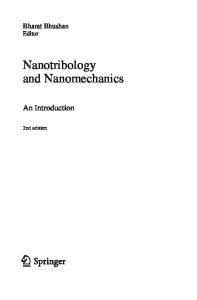Influence of Crystallographic Orientation on Nanoscale Friction and Wear Mechanisms of the AZ91 Alloy
- PDF / 4,448,581 Bytes
- 10 Pages / 595.276 x 790.866 pts Page_size
- 56 Downloads / 319 Views
ORIGINAL PAPER
Influence of Crystallographic Orientation on Nanoscale Friction and Wear Mechanisms of the AZ91 Alloy Deepak Kumar1 · Nitya Nand Gosvami1 · Jayant Jain1 Received: 12 April 2020 / Accepted: 7 August 2020 © Springer Science+Business Media, LLC, part of Springer Nature 2020
Abstract In the present study, nanoscale friction and wear behavior of the AZ91 alloy with respect to crystallographic orientations (basal, pyramidal and prismatic) were examined. The hardness of different crystallographic orientation was measured using nanoindentation. Load-dependent friction and wear behavior was investigated using atomic force microscopy (AFM). Electron back scattered diffraction (EBSD) was used to investigate the deformation behavior post-indentation and wear. A strong anisotropy in hardness, friction and wear with respect to crystallographic orientation was observed. The basal oriented grain was found to be most wear-resistant followed by prismatic and pyramidal oriented grains. The friction results corroborated the wear data. Additionally, the model proposed by Song et al. has been used to quantify the orientation dependence of friction values. Finally, it is anticipated that these results will enable the development of orientation informed surfaces for controlling the wear and friction response of materials. Keywords AFM · Crystallographic orientations · Friction · Wear · Mg alloy
1 Introduction Magnesium (Mg) and its alloys are considered to be the lightest structural metallic materials [1]. They have great potential for applications in aerospace and automotive sectors. However, poor tribological properties of Mg alloys restricts their applications in sliding interfaces such as bearings, gears, piston-cylinder assembly, and sliding seals [2, 3]. Till now, several approaches have been proposed to improve the tribological properties of Mg and its alloys such as altering crystallographic texture, environmental control including operating temperature and lubrication, and mechanical properties [4–7]. Among all approaches, texture control is an important approach to tune the tribological properties of Electronic supplementary material The online version of this article (https://doi.org/10.1007/s11249-020-01330-9) contains supplementary material, which is available to authorized users. * Nitya Nand Gosvami [email protected] * Jayant Jain [email protected] 1
Department of Materials Science and Engineering, Indian Institute of Technology, New Delhi 110016, India
the materials, where controlling grain orientation can result in improved mechanical and tribological properties. In the past, few studies have been conducted to measure the grain orientation effect on mechanical properties of Mg alloys. Selvarajou et al. [8] reported that pure Mg shows strong anisotropic properties for different grain orientations. The nanohardness of basal plane was found to be significantly higher than the prismatic plane. Similarly, Bočan et al. [9] measured the nanomechanical properties of the pure Mg and the AZ31 alloy an
Data Loading...











